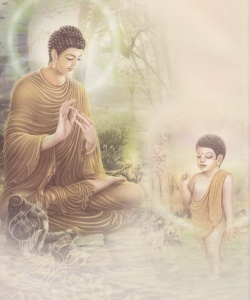Difference between revisions of "Arupa Jhanas"
| (One intermediate revision by the same user not shown) | |||
| Line 1: | Line 1: | ||
[[File:Buddhanew12.jpg|thumb|250px|]] | [[File:Buddhanew12.jpg|thumb|250px|]] | ||
| + | |||
| + | |||
| + | |||
| + | |||
| + | |||
| + | |||
| + | |||
| + | |||
<poem> | <poem> | ||
| − | [[Arūpajhāna]]; In [[Buddhism]], the [[arūpajhānas]] or "[[formless meditations]]" are four successive levels of [[meditation]] on non-material [[objects]]. These levels are higher than the [[rūpajhānas]], and harder to attain. In themselves, they are believed to lead to [[rebirth]] as [[gods]] belonging to the [[realm]] of the same [[name]]. | + | [[Arūpajhāna]]; In [[Buddhism]], the [[arūpajhānas]] or "[[formless meditations]]" are four successive levels of [[meditation]] on non-material [[objects]]. |
| + | |||
| + | These levels are higher than the [[rūpajhānas]], and harder to attain. In themselves, they are believed to lead to [[rebirth]] as [[gods]] belonging to the [[realm]] of the same [[name]]. | ||
| + | |||
| − | The | + | The [[four arūpajhāna]] |
While [[rupajhanas]] differ considering their [[characteristics]], [[arupajhanas]] differ as their [[object]] is determined by the level of the [[jhana]]: | While [[rupajhanas]] differ considering their [[characteristics]], [[arupajhanas]] differ as their [[object]] is determined by the level of the [[jhana]]: | ||
| + | |||
[[fifth jhāna]]: [[infinite space]], | [[fifth jhāna]]: [[infinite space]], | ||
| Line 11: | Line 23: | ||
[[seventh jhāna]]: [[infinite nothingness]], | [[seventh jhāna]]: [[infinite nothingness]], | ||
[[eighth jhāna]]: [[neither perception nor non-perception]]. | [[eighth jhāna]]: [[neither perception nor non-perception]]. | ||
| + | |||
[[File:GuruRinpoche58.jpg|thumb|250px|]] | [[File:GuruRinpoche58.jpg|thumb|250px|]] | ||
This has to be understood. In the [[fourth rupajhana]], there is already [[Upekkha]], [[equanimity]] and [[Ekkagata]], [[concentration]], but the [[mind]] is still focused on a "[[material]]" [[object]], as any {{Wiki|color}}. | This has to be understood. In the [[fourth rupajhana]], there is already [[Upekkha]], [[equanimity]] and [[Ekkagata]], [[concentration]], but the [[mind]] is still focused on a "[[material]]" [[object]], as any {{Wiki|color}}. | ||
| − | In the [[fifth jhana]], the [[meditator]] discovers that there is no [[object]], but only an [[infinite]] [[space]], which is [[empty]]. This [[perception]] motivates the [[interest]] of claiming [[arupajhanas]]. | + | |
| + | In the [[fifth jhana]], the [[meditator]] discovers that there is no [[object]], but only an [[infinite]] [[space]], which is [[empty]]. | ||
| + | |||
| + | This [[perception]] motivates the [[interest]] of claiming [[arupajhanas]]. | ||
| + | |||
| + | |||
In the [[sixth jhana]], it becomes obvious that [[space]] has no [[existence]]. There is only [[infinite consciousness]]. | In the [[sixth jhana]], it becomes obvious that [[space]] has no [[existence]]. There is only [[infinite consciousness]]. | ||
In the [[seventh jhana]] appears the [[feeling]] that there is no [[consciousness]], but [[nothingness]]. | In the [[seventh jhana]] appears the [[feeling]] that there is no [[consciousness]], but [[nothingness]]. | ||
The [[eighth jhana]] consists in the most discrete possible [[state of mind]], which justifies the using of "[[neither perception nor non-perception]]". | The [[eighth jhana]] consists in the most discrete possible [[state of mind]], which justifies the using of "[[neither perception nor non-perception]]". | ||
| − | These "explanations" do not refer to any {{Wiki|intellectual}}, {{Wiki|philosophical}} [[comprehension]], which disappear since the [[second jhana]]. They attempt to figure [[mental]] process. The [[arūpajhānas]] are part of the [[kammatthanas]], and are referred to as the four "[[formless states]]". | + | |
| + | These "explanations" do not refer to any {{Wiki|intellectual}}, {{Wiki|philosophical}} [[comprehension]], which disappear since the [[second jhana]]. They attempt to figure [[mental]] process. | ||
| + | |||
| + | The [[arūpajhānas]] are part of the [[kammatthanas]], and are referred to as the four "[[formless states]]". | ||
The two [[elements]] of [[arūpajhāna]] | The two [[elements]] of [[arūpajhāna]] | ||
| − | Some [[Tipitaka]] texts identify [[arūpajhānas]] as a part of the fourth [[rūpajhāna]], as they include two [[elements]]: [[upekkhā]] ([[Sanskrit]]: [[upekṣā]]) and [[ekaggatā]] (Skt: [[ekāgratā]]). | + | |
| + | Some [[Tipitaka]] texts identify [[arūpajhānas]] as a part of [[the fourth]] [[rūpajhāna]], as they include two [[elements]]: [[upekkhā]] ([[Sanskrit]]: [[upekṣā]]) and [[ekaggatā]] (Skt: [[ekāgratā]]). | ||
[[Upekkha]] | [[Upekkha]] | ||
| − | [[Upekkhā]] is a [[Pali]] [[word]] meaning [[equanimity]]. The [[opposition]] between comfortable [[sensations]] and uncomfortable ones disappears. More importantly, it is one of the fourth [[Jhāna]]'s factors, {{Wiki|present}} only in this [[Jhāna]]. | + | [[Upekkhā]] is a [[Pali]] [[word]] meaning [[equanimity]]. |
| + | |||
| + | The [[opposition]] between comfortable [[sensations]] and uncomfortable ones disappears. More importantly, it is one of [[the fourth]] [[Jhāna]]'s factors, {{Wiki|present}} only in this [[Jhāna]]. | ||
[[Ekaggatā]] | [[Ekaggatā]] | ||
Latest revision as of 19:19, 29 December 2023
Arūpajhāna; In Buddhism, the arūpajhānas or "formless meditations" are four successive levels of meditation on non-material objects.
These levels are higher than the rūpajhānas, and harder to attain. In themselves, they are believed to lead to rebirth as gods belonging to the realm of the same name.
The four arūpajhāna
While rupajhanas differ considering their characteristics, arupajhanas differ as their object is determined by the level of the jhana:
fifth jhāna: infinite space,
sixth jhāna: infinite consciousness,
seventh jhāna: infinite nothingness,
eighth jhāna: neither perception nor non-perception.
This has to be understood. In the fourth rupajhana, there is already Upekkha, equanimity and Ekkagata, concentration, but the mind is still focused on a "material" object, as any color.
In the fifth jhana, the meditator discovers that there is no object, but only an infinite space, which is empty.
This perception motivates the interest of claiming arupajhanas.
In the sixth jhana, it becomes obvious that space has no existence. There is only infinite consciousness.
In the seventh jhana appears the feeling that there is no consciousness, but nothingness.
The eighth jhana consists in the most discrete possible state of mind, which justifies the using of "neither perception nor non-perception".
These "explanations" do not refer to any intellectual, philosophical comprehension, which disappear since the second jhana. They attempt to figure mental process.
The arūpajhānas are part of the kammatthanas, and are referred to as the four "formless states".
The two elements of arūpajhāna
Some Tipitaka texts identify arūpajhānas as a part of the fourth rūpajhāna, as they include two elements: upekkhā (Sanskrit: upekṣā) and ekaggatā (Skt: ekāgratā).
Upekkha
Upekkhā is a Pali word meaning equanimity.
The opposition between comfortable sensations and uncomfortable ones disappears. More importantly, it is one of the fourth Jhāna's factors, present only in this Jhāna.
Ekaggatā
Ekaggatā or "singlepointedness", as a Jhāna's factor, simply means a very deep concentration, which includes the ceasing of stimuli from the exterior world. It is the only jhānic factor present in each Jhāna.

